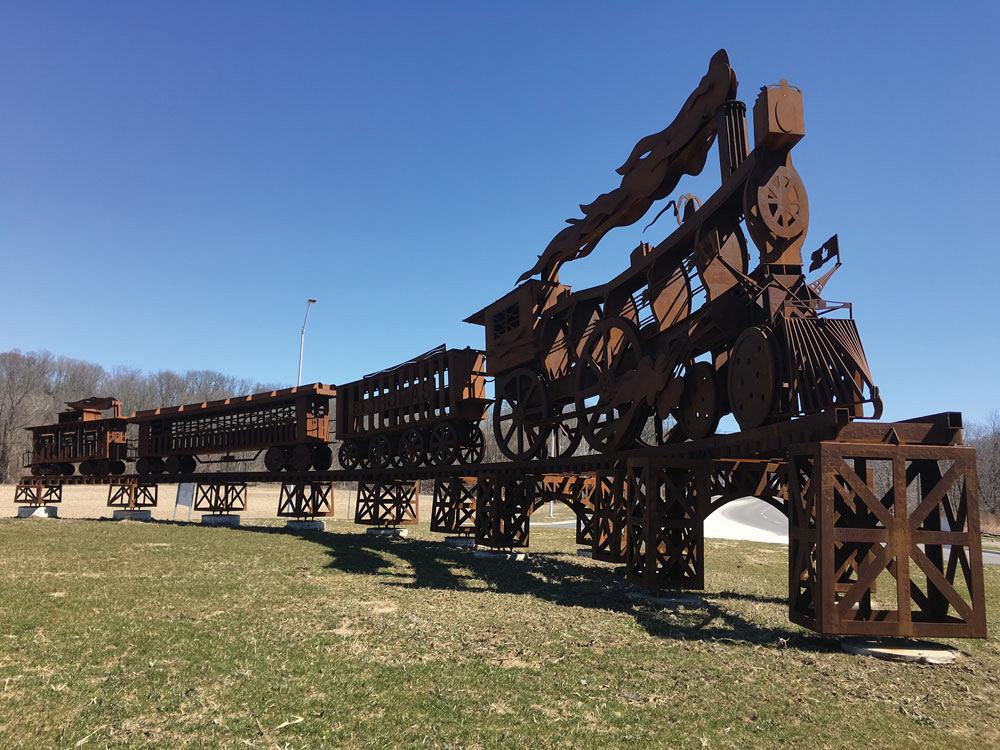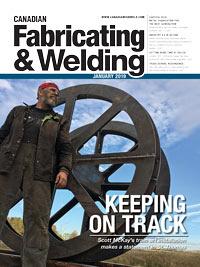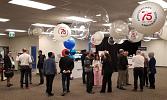Associate Editor
- FMA
- The Fabricator
- FABTECH
- Canadian Metalworking
Scott McKay creates 25-ton train art in St. Thomas, Ont.
St. Thomas, Ont., is known as the railway city, and thanks to Scott McKay, the city has commemorated its history with a 69-foot-long, 20-foot-tall art installation called “Perseverance”.
- By Lindsay Luminoso
- January 24, 2019
- Article
- Fabricating

Artist blacksmith Scott McKay spent 5 months and over 1,000 hours creating thousands of components ranging from large, heavy plate to palm-sized parts.
St. Thomas, Ont., is known as the railway city in part because the train system was integral to its history and development. The city wanted to represent its important history with an art installation located at the Gateway Roundabout in the middle of town.
Driving toward the city, visitors are greeted by a 25-ton train with a steam locomotive that pulls a coal car, passenger car, and caboose. This 69-foot-long, 20-foot-tall art installation, called "Perseverance," was designed and created by Scott McKay at Strong Arm Forge, Lawrence Station, Ont.
"The city had a couple of ideas in mind for the roundabout, but they definitely wanted a railway theme," said McKay. "So I put together a couple ideas on paper and brought it back to them and we went from there. With this project, I wanted to design a concept where people can walk around it and get a real feel for it."
Beyond 2D drawings on paper, McKay also created a 3D model using cardboard to really demonstrate the unique and highly detailed features of his design.
This was by far one of the largest projects, by tonnage and dollar value, that McKay had ever undertaken. Before opening his own shop, McKay worked as a millwright and moved into maintenance planning at the diamond mine in northern Canada. While working in maintenance planning, he started using AutoCAD®. He credits this prior work to helping him think big and feel comfortable taking on larger, unique jobs.
Design Elements
The city provided McKay with minimal parameters, basically giving him just the space size, and let him go from there. McKay shared only details of the centre radius of the train track because the city was responsible for putting the piers and supports in the ground. It was also an essential detail because the entire train was built off that one measurement. McKay created a bill of materials and ordered 55,000 lbs. of CORTEN ® steel, equalling 140 sheets. Before the steel arrived, McKay poured a 30-ft. by 12-ft. concrete pad in his yard to give him a place to build the train outside the shop.
"I had the weathering steel along the driveway," he explained. "I hadn’t worked on a project of this scale before. I had to move the stock around a number of times because it was sinking into the ground. I also rented a forklift to handle the weight I was going to be dealing with."
The total length of the train down the centreline measures 69 ft., so McKay began building the tracks, which took him twice as long as he anticipated. There are 550 individual parts in the tracks alone, with over 1,700 parts in total. McKay did as much as he could in his 1,200-sq.-ft. shop, taking advantage of gas metal arc welding’s high speed. But when he had to move outside, everything had to be stick welded, most of it up-hand, to attain the necessary strength levels.
After the tracks were completed, McKay started on the train itself, which was built directly on the tracks.
Because he lacked open space, McKay fabricated only the caboose entirely in the shop. Everything else was assembled outside on the concrete pad. He worked methodically by producing cutting drawings two days in advance of actually cutting the material. The locomotive was the first to be built.

“Perseverance”, a 69-foot-long, 20-foot-tall train, was installed in the Gateway Roundabout to commemorate St. Thomas’ railway heritage.
"The tracks taper 12 in. over 69 ft., so if the dimensions were even a little bit off when the train was being built, it could not fit and really screw things up down the line," McKay explained.
Cutting and Fabricating
His shop was equipped with a CNC plasma cutter with a Hypertherm Powermax45 hooked up. This was adequate when McKay was working on material ¼ or ⅜ in. thick, but he needed something more powerful and faster to get the train job done.
"I’ve always found that the higher power leaves a nicer cut, especially when you are pushing the machine to max all the time," he explained. "That’s why I upgraded to the Powermax65." McKay cut and fabricated the plates during the day and spent the nights on his computer ensuring that all details and specifications were calculated correctly. He also spent a significant amount of time going over every edge with a grinder to remove any dross.
He faced some challenges during the project. When he first started to cut the steel on his table, the parameters initially suggested by the table manufacturer were not ideal for the work he was doing.
"I set the machine up and then I’d have to stand there and watch to make sure that things wouldn’t get jammed up," said McKay. "That’s why the tracks took me so long. Once I finally spoke with an expert and upped the voltage, that opened things up a little."
However, partway through the project, McKay suffered a repetitive strain injury in his back, which forced him to pause the project for about a week. Rather than hire additional workers, McKay was adamant to see the job through from beginning to end.
"I’m thrilled with the whole thing because I did it all by myself," said McKay. "I dealt with some pretty heavy pieces with varying sizes. The smokestack was made from ¼-in. plate, and the smoke itself was created by fabricating an 18-ft. beam and then attaching the ¼-in. plate smoke to it. I did it all on the CNC plasma table with limited space in my shop."
Installation
To get all of the components from his shop to the site, which is approximately 20 minutes away, McKay coordinated with a machinery moving company for a crane and flatbed truck. However, the moving company had a last-minute conflict and could not come the day before the installation to move the components to the site, so McKay borrowed a trailer and took everything to the site on his own, with the exception of the 12,000-lb. locomotive.
The city had blocked off the roundabout to allow for the large train components to be brought in, and a 90-ton crane slowly moved the parts into place. For the piers, McKay rented a front-end loader to help set up and install them. This occurred about a week prior to the train installation date. McKay noted that he did give himself a little wiggle room for the piers, and only one was slightly out of place but not enough to affect installation. Once McKay got the locomotive and track to the site, he was able to start assembly and welding components together.
Finishing Touches
"I chose COR-TEN for the project so that the city would never have to worry about maintenance on the sculpture," said McKay. Having worked as a maintenance man in the past, he certainly does not like to sell something that requires customers to deal with lots of upkeep. He also joked that he’s heard many people questioning when the train will be painted, which it never will.

With over 1,700 parts in total to fabricate, McKay did as much as he could in his 1,200-sq.-ft. shop, taking advantage of gas metal arc welding’s high speed.
"The weathering steel was part of the sell to the city," he said. "The city was considering buying an old locomotive, but it would need to be painted and require ongoing maintenance. That’s why I suggested COR-TEN steel; there’s real beauty in it. It’s supposed to rust, protecting itself. Now that it’s been in place for a while, I often hear people saying how awesome it looks."
McKay started the project in mid-July 2017 and finished fabricating on Dec. 13. The entire train and tracks were installed on Dec. 15 of that year. The project itself took over 1,000 hours and had thousands of components ranging from large, heavy plate to palm-sized parts.
"Creating ‘Perseverance’ was a great experience," said McKay. "It was the culmination of my art experience and very much supported by my past millwrighting and planning experience in heavy industry and mining. The challenge of the task was daunting on more than one occasion, but I would zoom down and focus on the task at hand for the day when things seemed overwhelming. I drive by the sculpture many times in a week and recall the details of each entity. At times it still seems a bit incredible to me that I built it. I would certainly like to think there are bigger projects ahead. It takes an opportunity and the perseverance to complete it."
Associate Editor Lindsay Luminoso can be reached at lluminoso@canadianfabweld.com.
Hypertherm, www.hypertherm.com
Strong Arm Forge, www.strongarmforge.com
About the Author

Lindsay Luminoso
1154 Warden Avenue
Toronto, M1R 0A1 Canada
Lindsay Luminoso, associate editor, contributes to both Canadian Metalworking and Canadian Fabricating & Welding. She worked as an associate editor/web editor, at Canadian Metalworking from 2014-2016 and was most recently an associate editor at Design Engineering.
Luminoso has a bachelor of arts from Carleton University, a bachelor of education from Ottawa University, and a graduate certificate in book, magazine, and digital publishing from Centennial College.
Related Companies
subscribe now


Keep up to date with the latest news, events, and technology for all things metal from our pair of monthly magazines written specifically for Canadian manufacturers!
Start Your Free Subscription- Industry Events
MME Saskatoon
- May 28, 2024
- Saskatoon, SK Canada
CME's Health & Safety Symposium for Manufacturers
- May 29, 2024
- Mississauga, ON Canada
DiPaolo Machine Tools Open House 2024
- June 4 - 5, 2024
- Mississauga, ON Canada
FABTECH Canada
- June 11 - 13, 2024
- Toronto, ON Canada
Zoller Open House & Technology Days 2024
- June 12 - 13, 2024
- Ann Arbor, MI





















